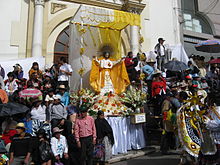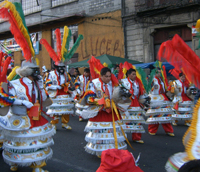
The Festival of the Lord Jesus of Great Power, usually known as El Gran Poder, is a religious celebration that takes place in the city of La Paz in the Andean Altiplano in Bolivia. It takes place every year on a Saturday at the end of May or beginning of June. A huge parade of dancers moves along a several-kilometer-long route in the city center. This festival takes place in homage to the representation of the Lord Jesus that is worshipped on this day in the church of San Antonio Gallardo.
Huge devotion is expressed during this festival. Actually it is the most important festival of the year in La Paz. Spectators take their chairs or buy a spot in the stands that are set up along the parade route in order to watch the parade and enjoy the dances, bands and stands selling food and beverages typical of the region. Currently 53 folkloric fraternities participate in the parade with 30,000 dancers and 4000 musicians.
The “preste”:
The name of the event and of the person who organizes and finances the fraternity's private party celebrated the following day is El “preste.” A hall is rented for the party, and a typical dish is served to the participants. Several bands are hired to play music at the party which lasts all day Sunday. This type of event could cost between $8,000 and $15,000, a significant amount when we know that the minimum salary in Bolivia is around 100 Euros per month. Each fraternity accepts temporary dancers, but most of them dance for several years, some even for generations. The "permanent" members have to take the role of preste at least once in order to be considered a prestigious and respected person. Each member tries to outdo the previous preste. The more complete and luxurious the party, the more the group admires and respects the preste. This way the savings accumulated for several years are spent in one, two or three days, because sometimes the party continues through Tuesday.
 This custom shows an Andean view of distribution of wealth like in the communities in the Altiplano of the Andes where reciprocity is fundamental to the well-being of society. It is referred to as Ayni which means "today for you and tomorrow for me" in the Aymara language. The preste is a type of economic reciprocity with the dance fraternity as well as with God since the dancers parade to ask protection of the Lord and fulfillment of their wishes or projects.
This custom shows an Andean view of distribution of wealth like in the communities in the Altiplano of the Andes where reciprocity is fundamental to the well-being of society. It is referred to as Ayni which means "today for you and tomorrow for me" in the Aymara language. The preste is a type of economic reciprocity with the dance fraternity as well as with God since the dancers parade to ask protection of the Lord and fulfillment of their wishes or projects.
The Festival of the Gran Poder is a symbol of religious unification that mixes Catholic traditions with Aymara customs. For example, the night before the parade, the participants make their promise to the Lord, committing themselves to dance for three consecutive years so their wishes may become reality. This promise is accompanied by a ceremony to the Pachamama (Mother Earth) wherein a set of objects made of sugar is burned as an offering to request protection during the celebration of Gran Poder and for daily life.
History of the Day of Gran Poder:
The expression Gran Poder comes from the belief that God is love and that love generates a power that destroys all obstacles.
The festival originated on December 8, 1663, when the Sheltering Mothers (Madres Concebiditas) convent was established. According to the story, the candidates must bring an image to the convent with them. A nun named Genoveva Carrión brought an image of the Lord with three faces that caused a controversy.
 In 1904 a worshiper decided to cut the image which to date only shows one face. After this act, many devotees received favors from the Lord, which is how veneration of the image spread. The image passed by the houses on Mercado, Yungas and Figueroa streets and the Iglesia del Rosario church. Then it was moved to San Leo Barra where a devout family began the homage to the image with visits and prayers scheduled for Tuesday and Friday.
In 1904 a worshiper decided to cut the image which to date only shows one face. After this act, many devotees received favors from the Lord, which is how veneration of the image spread. The image passed by the houses on Mercado, Yungas and Figueroa streets and the Iglesia del Rosario church. Then it was moved to San Leo Barra where a devout family began the homage to the image with visits and prayers scheduled for Tuesday and Friday.
Over time, the numbers of the faithful grew, and in 1928 building began on a church in the Chijini neighborhood which today is Gallardo street. The work was completed at the end of 1930.
Beginning of the parade:
In 1923 the first demonstrations of popular dance appeared on Illampu street where the shops were located for embroidering folkloric dance costumes. The Chuquimiay and Gisbert families were among the most influential, and their initiative began the first celebrations in honor of the Lord.
In 1924 the first parade of Diablada dancers appeared, and a group of bootblacks called the "Cebollitas" (Little Onions) danced the Suri Sikuri.
In the 30s and 40s, groups from the Yungas began to join the parade and added drums to the dances. In 1952 the party became a departmental event with a huge dance parade in La Paz. At that time the idea of a more organized and significant parade arose. Organization of the event had support from a priest named Camacho who organized the practices at night from Buenos Aires Avenue through the intersection of Gallardo Segurola.
On January 25, 1969, the Caporales dance was created in the Chijini neighborhood as an act of devotion to the Lord of the Gran Poder. Finally on May 12, 1974, the Association of folkloric groups was founded, turning the event into a national festival that is celebrated annually in the city of La Paz still today.


